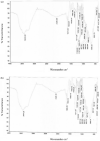Manufacturing and characterization of whey and stevia-based popsicles enriched with concentrated beetroot juice
- PMID: 35875238
- PMCID: PMC9304454
- DOI: 10.1007/s13197-022-05364-w
Manufacturing and characterization of whey and stevia-based popsicles enriched with concentrated beetroot juice
Abstract
The beet-root (Beta vulgaris) and whey powder together, can potentially use as a multifunctional ingredient in the manufacturing of the "Popsicles", due to their biochemical composition that can enhance the concentration of bioactive compounds. In the present study, beet-root juice concentrates were prepared at different time/temperature treatments viz 45 °C, 55 °C, and 65 °C for 120, 80 and 45 min. The effect of different time/temperature treatments on physicochemical composition, colour, antioxidant activity (%), bioactive compounds, spectral data and sensory acceptance were evaluated. The physicochemical parameters of popsicles (PTI, PT2, PT3) including protein, total phenols, betalain, radical scavenging activity %, colour and melting values were significantly affected (p ≤ 0.05) by the different time/temperature treatments. The concentration of betalain and protein in all the popsicles ranged from 1134 to 1299 mg/L and 1.92 to 1.54 g/100 g respectively. The reduction of bioactive components viz betacyanins, betaxanthins, betanin, oxalic and syringic acid was also observed in popsicle (PTI) as compared to control. Furthermore, popsicle (PT1) was prepared with beet-root juice concentrated at 45 °C showed maximum sensory acceptance. The physicochemical and organoleptic attributes of processed popsicles encourage the commercial usage of whey powder and concentrated beetroot juice.
Keywords: Beetroot; Bioactive; Colour; Popsicle; Whey powder.
© Association of Food Scientists & Technologists (India) 2022.
Conflict of interest statement
Conflict of interestNone of the authors have any conflict of interest in the manuscript.
Figures
Similar articles
-
Chemical, sensory, and functional properties of whey-based popsicles manufactured with watermelon juice concentrated at different temperatures.Food Chem. 2018 Jul 30;255:58-66. doi: 10.1016/j.foodchem.2018.02.044. Epub 2018 Feb 9. Food Chem. 2018. PMID: 29571498
-
Influence of High-Pressure Homogenization on the Physicochemical Properties and Betalain Pigments of Red Beetroot (Beta vulgaris L.) Juice.Molecules. 2023 Feb 21;28(5):2018. doi: 10.3390/molecules28052018. Molecules. 2023. PMID: 36903265 Free PMC article.
-
Preharvest application of ethephon and postharvest UV-B radiation improve quality traits of beetroot (Beta vulgaris L. ssp. vulgaris) as source of colourant.BMC Plant Biol. 2018 Dec 3;18(1):316. doi: 10.1186/s12870-018-1556-2. BMC Plant Biol. 2018. PMID: 30509181 Free PMC article.
-
Red Beetroot Betalains: Perspectives on Extraction, Processing, and Potential Health Benefits.J Agric Food Chem. 2020 Oct 21;68(42):11595-11611. doi: 10.1021/acs.jafc.0c04241. Epub 2020 Oct 11. J Agric Food Chem. 2020. PMID: 33040529 Review.
-
Betanin--a food colorant with biological activity.Mol Nutr Food Res. 2015 Jan;59(1):36-47. doi: 10.1002/mnfr.201400484. Epub 2014 Oct 3. Mol Nutr Food Res. 2015. PMID: 25178819 Review.
References
-
- AOAC International (2005) Official methods of analysis of AOAC International. AOAC International
-
- Aykın-Dinçer E, Güngör KK, Çağlar E, Erbaş M. The use of beetroot extract and extract powder in sausages as natural food colorant. Int J Food Eng. 2021;17:75–82. doi: 10.1515/ijfe-2019-0052. - DOI
-
- Babarykin D, Smirnova G, Pundinsh I, et al. Red beet (Beta vulgaris) impact on human health. J Biosci Med. 2019;07:61–79. doi: 10.4236/jbm.2019.73007. - DOI
LinkOut - more resources
Full Text Sources

